Business Model Analysis of Roofoods (Deliveroo) - MGMT20143
VerifiedAdded on 2022/10/11
|10
|2170
|16
Report
AI Summary
This report provides a comprehensive analysis of Roofoods Ltd., branded as Deliveroo, an online food delivery enterprise. The report deconstructs Deliveroo's business model using the nine building blocks of the Osterwalder & Pigneur Canvas, detailing customer segments, value propositions, channels, customer relationships, key activities, key resources, key partnerships, cost structures, and revenue streams. It highlights interrelationships between various aspects of the business, identifying critical success factors such as personalization, customer loyalty, and technology optimization. The report also discusses potential risks, including physical damage to food, technology glitches, and security breaches, and offers recommendations for improving the business model, such as addressing rider pay concerns and expanding into underserved areas. The analysis draws on various sources and provides a detailed overview of Deliveroo's operational strategies and future prospects.
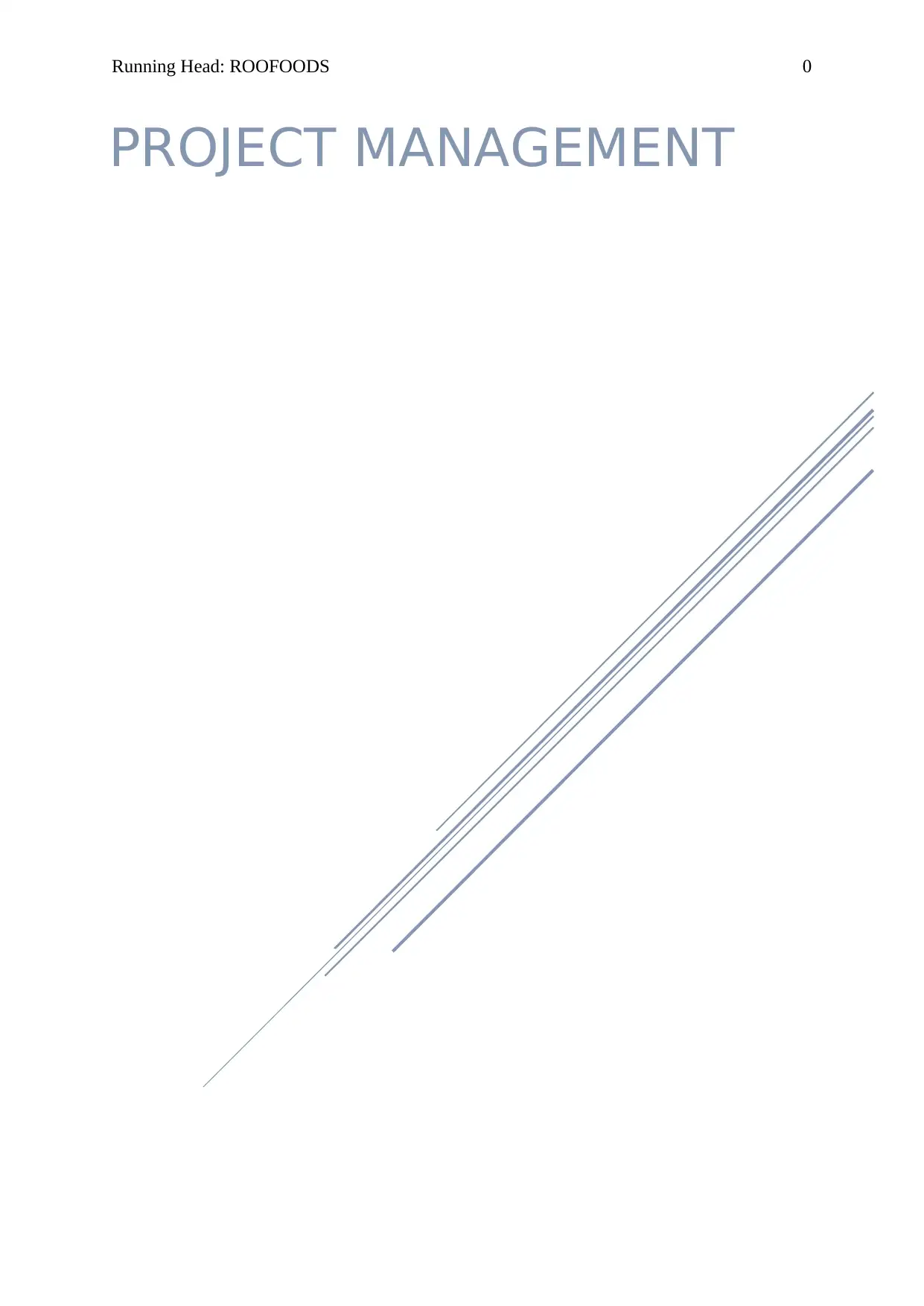
Running Head: ROOFOODS 0
PROJECT MANAGEMENT
PROJECT MANAGEMENT
Paraphrase This Document
Need a fresh take? Get an instant paraphrase of this document with our AI Paraphraser
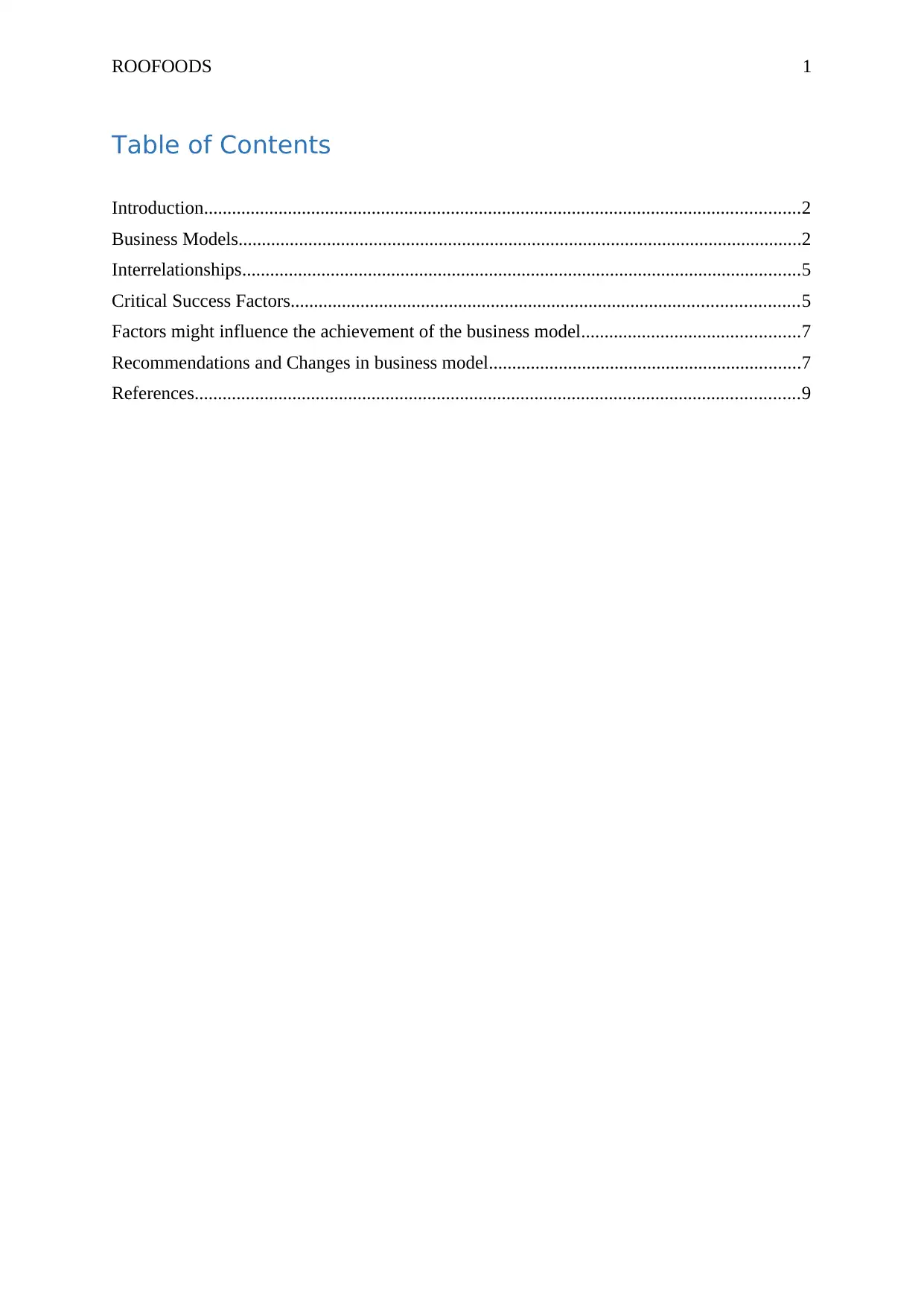
ROOFOODS 1
Table of Contents
Introduction................................................................................................................................2
Business Models.........................................................................................................................2
Interrelationships........................................................................................................................5
Critical Success Factors.............................................................................................................5
Factors might influence the achievement of the business model...............................................7
Recommendations and Changes in business model...................................................................7
References..................................................................................................................................9
Table of Contents
Introduction................................................................................................................................2
Business Models.........................................................................................................................2
Interrelationships........................................................................................................................5
Critical Success Factors.............................................................................................................5
Factors might influence the achievement of the business model...............................................7
Recommendations and Changes in business model...................................................................7
References..................................................................................................................................9
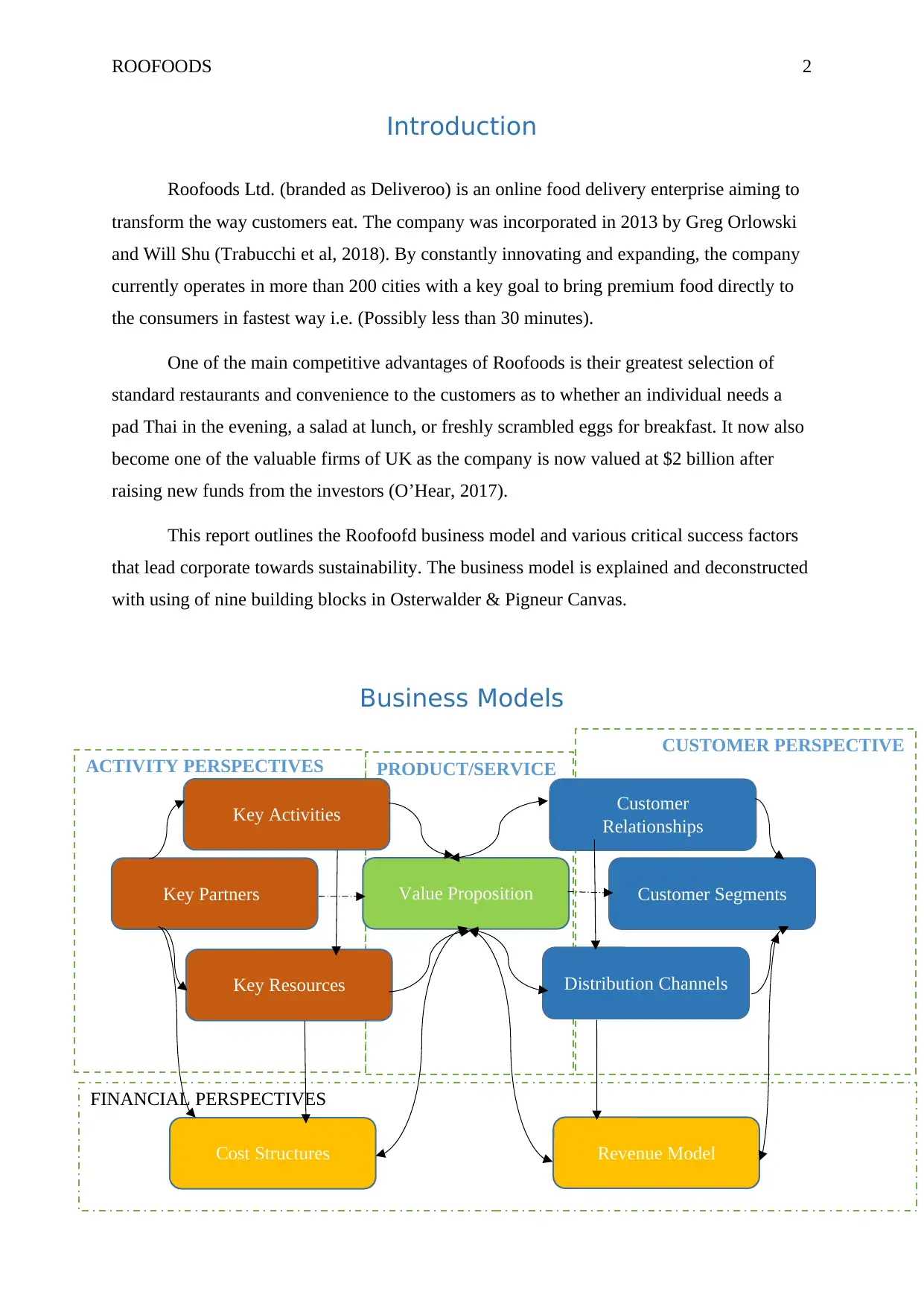
ROOFOODS 2
Introduction
Roofoods Ltd. (branded as Deliveroo) is an online food delivery enterprise aiming to
transform the way customers eat. The company was incorporated in 2013 by Greg Orlowski
and Will Shu (Trabucchi et al, 2018). By constantly innovating and expanding, the company
currently operates in more than 200 cities with a key goal to bring premium food directly to
the consumers in fastest way i.e. (Possibly less than 30 minutes).
One of the main competitive advantages of Roofoods is their greatest selection of
standard restaurants and convenience to the customers as to whether an individual needs a
pad Thai in the evening, a salad at lunch, or freshly scrambled eggs for breakfast. It now also
become one of the valuable firms of UK as the company is now valued at $2 billion after
raising new funds from the investors (O’Hear, 2017).
This report outlines the Roofoofd business model and various critical success factors
that lead corporate towards sustainability. The business model is explained and deconstructed
with using of nine building blocks in Osterwalder & Pigneur Canvas.
Business Models
FINANCIAL PERSPECTIVES
CUSTOMER PERSPECTIVE
PRODUCT/SERVICEACTIVITY PERSPECTIVES
Key Activities
Key Partners
Key Resources
Value Proposition
Customer
Relationships
Customer Segments
Distribution Channels
Cost Structures Revenue Model
Introduction
Roofoods Ltd. (branded as Deliveroo) is an online food delivery enterprise aiming to
transform the way customers eat. The company was incorporated in 2013 by Greg Orlowski
and Will Shu (Trabucchi et al, 2018). By constantly innovating and expanding, the company
currently operates in more than 200 cities with a key goal to bring premium food directly to
the consumers in fastest way i.e. (Possibly less than 30 minutes).
One of the main competitive advantages of Roofoods is their greatest selection of
standard restaurants and convenience to the customers as to whether an individual needs a
pad Thai in the evening, a salad at lunch, or freshly scrambled eggs for breakfast. It now also
become one of the valuable firms of UK as the company is now valued at $2 billion after
raising new funds from the investors (O’Hear, 2017).
This report outlines the Roofoofd business model and various critical success factors
that lead corporate towards sustainability. The business model is explained and deconstructed
with using of nine building blocks in Osterwalder & Pigneur Canvas.
Business Models
FINANCIAL PERSPECTIVES
CUSTOMER PERSPECTIVE
PRODUCT/SERVICEACTIVITY PERSPECTIVES
Key Activities
Key Partners
Key Resources
Value Proposition
Customer
Relationships
Customer Segments
Distribution Channels
Cost Structures Revenue Model
⊘ This is a preview!⊘
Do you want full access?
Subscribe today to unlock all pages.

Trusted by 1+ million students worldwide
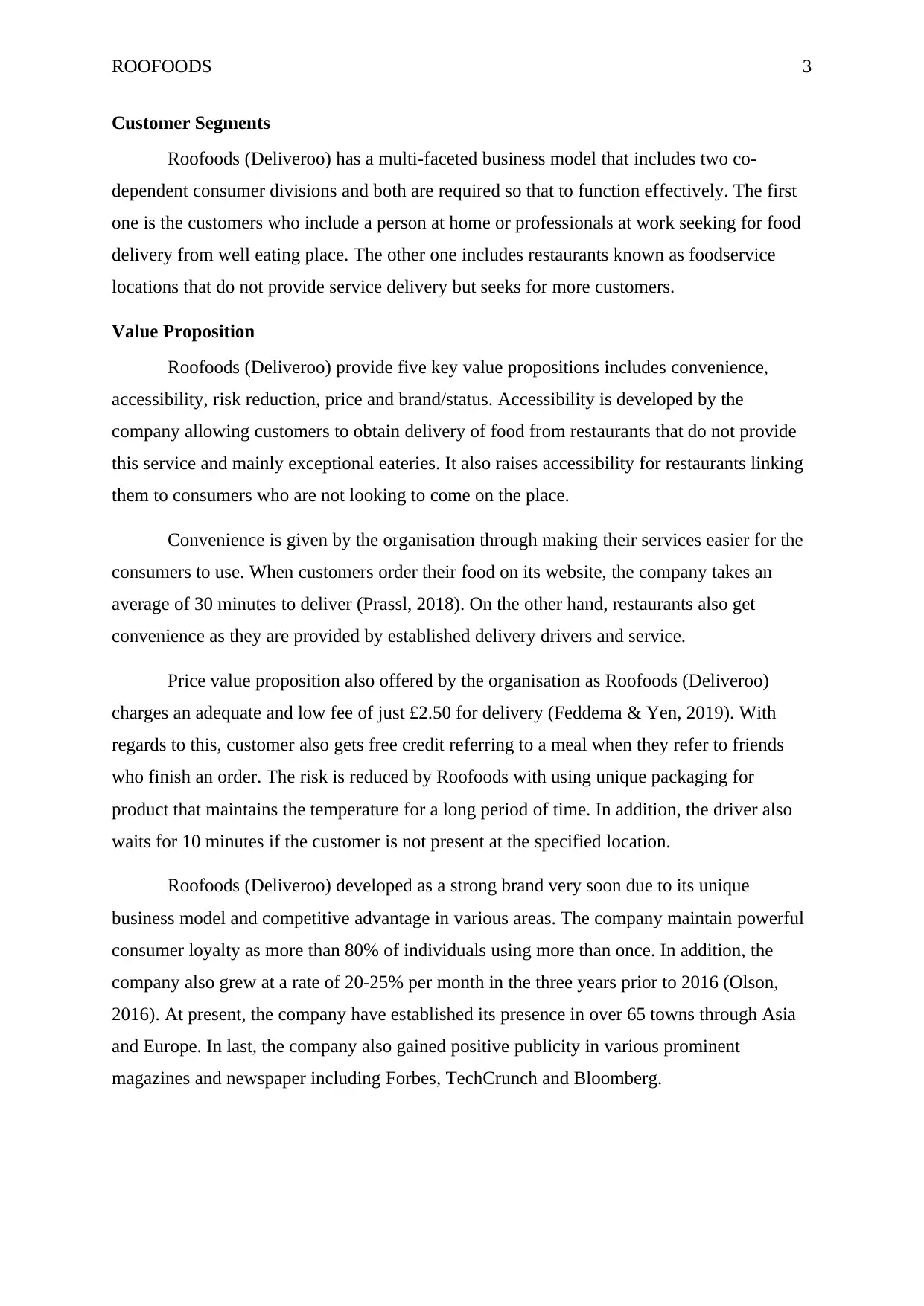
ROOFOODS 3
Customer Segments
Roofoods (Deliveroo) has a multi-faceted business model that includes two co-
dependent consumer divisions and both are required so that to function effectively. The first
one is the customers who include a person at home or professionals at work seeking for food
delivery from well eating place. The other one includes restaurants known as foodservice
locations that do not provide service delivery but seeks for more customers.
Value Proposition
Roofoods (Deliveroo) provide five key value propositions includes convenience,
accessibility, risk reduction, price and brand/status. Accessibility is developed by the
company allowing customers to obtain delivery of food from restaurants that do not provide
this service and mainly exceptional eateries. It also raises accessibility for restaurants linking
them to consumers who are not looking to come on the place.
Convenience is given by the organisation through making their services easier for the
consumers to use. When customers order their food on its website, the company takes an
average of 30 minutes to deliver (Prassl, 2018). On the other hand, restaurants also get
convenience as they are provided by established delivery drivers and service.
Price value proposition also offered by the organisation as Roofoods (Deliveroo)
charges an adequate and low fee of just £2.50 for delivery (Feddema & Yen, 2019). With
regards to this, customer also gets free credit referring to a meal when they refer to friends
who finish an order. The risk is reduced by Roofoods with using unique packaging for
product that maintains the temperature for a long period of time. In addition, the driver also
waits for 10 minutes if the customer is not present at the specified location.
Roofoods (Deliveroo) developed as a strong brand very soon due to its unique
business model and competitive advantage in various areas. The company maintain powerful
consumer loyalty as more than 80% of individuals using more than once. In addition, the
company also grew at a rate of 20-25% per month in the three years prior to 2016 (Olson,
2016). At present, the company have established its presence in over 65 towns through Asia
and Europe. In last, the company also gained positive publicity in various prominent
magazines and newspaper including Forbes, TechCrunch and Bloomberg.
Customer Segments
Roofoods (Deliveroo) has a multi-faceted business model that includes two co-
dependent consumer divisions and both are required so that to function effectively. The first
one is the customers who include a person at home or professionals at work seeking for food
delivery from well eating place. The other one includes restaurants known as foodservice
locations that do not provide service delivery but seeks for more customers.
Value Proposition
Roofoods (Deliveroo) provide five key value propositions includes convenience,
accessibility, risk reduction, price and brand/status. Accessibility is developed by the
company allowing customers to obtain delivery of food from restaurants that do not provide
this service and mainly exceptional eateries. It also raises accessibility for restaurants linking
them to consumers who are not looking to come on the place.
Convenience is given by the organisation through making their services easier for the
consumers to use. When customers order their food on its website, the company takes an
average of 30 minutes to deliver (Prassl, 2018). On the other hand, restaurants also get
convenience as they are provided by established delivery drivers and service.
Price value proposition also offered by the organisation as Roofoods (Deliveroo)
charges an adequate and low fee of just £2.50 for delivery (Feddema & Yen, 2019). With
regards to this, customer also gets free credit referring to a meal when they refer to friends
who finish an order. The risk is reduced by Roofoods with using unique packaging for
product that maintains the temperature for a long period of time. In addition, the driver also
waits for 10 minutes if the customer is not present at the specified location.
Roofoods (Deliveroo) developed as a strong brand very soon due to its unique
business model and competitive advantage in various areas. The company maintain powerful
consumer loyalty as more than 80% of individuals using more than once. In addition, the
company also grew at a rate of 20-25% per month in the three years prior to 2016 (Olson,
2016). At present, the company have established its presence in over 65 towns through Asia
and Europe. In last, the company also gained positive publicity in various prominent
magazines and newspaper including Forbes, TechCrunch and Bloomberg.
Paraphrase This Document
Need a fresh take? Get an instant paraphrase of this document with our AI Paraphraser
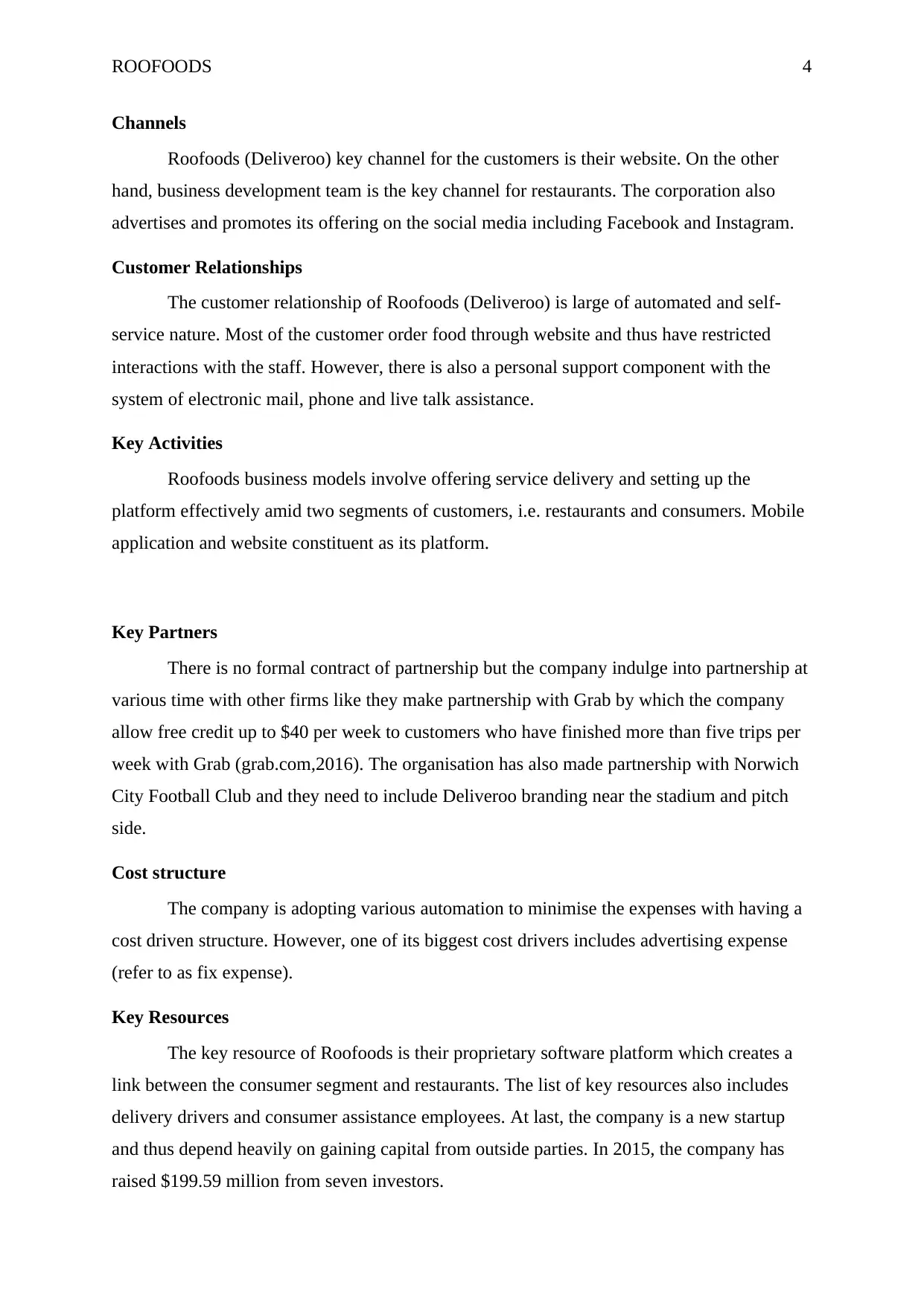
ROOFOODS 4
Channels
Roofoods (Deliveroo) key channel for the customers is their website. On the other
hand, business development team is the key channel for restaurants. The corporation also
advertises and promotes its offering on the social media including Facebook and Instagram.
Customer Relationships
The customer relationship of Roofoods (Deliveroo) is large of automated and self-
service nature. Most of the customer order food through website and thus have restricted
interactions with the staff. However, there is also a personal support component with the
system of electronic mail, phone and live talk assistance.
Key Activities
Roofoods business models involve offering service delivery and setting up the
platform effectively amid two segments of customers, i.e. restaurants and consumers. Mobile
application and website constituent as its platform.
Key Partners
There is no formal contract of partnership but the company indulge into partnership at
various time with other firms like they make partnership with Grab by which the company
allow free credit up to $40 per week to customers who have finished more than five trips per
week with Grab (grab.com,2016). The organisation has also made partnership with Norwich
City Football Club and they need to include Deliveroo branding near the stadium and pitch
side.
Cost structure
The company is adopting various automation to minimise the expenses with having a
cost driven structure. However, one of its biggest cost drivers includes advertising expense
(refer to as fix expense).
Key Resources
The key resource of Roofoods is their proprietary software platform which creates a
link between the consumer segment and restaurants. The list of key resources also includes
delivery drivers and consumer assistance employees. At last, the company is a new startup
and thus depend heavily on gaining capital from outside parties. In 2015, the company has
raised $199.59 million from seven investors.
Channels
Roofoods (Deliveroo) key channel for the customers is their website. On the other
hand, business development team is the key channel for restaurants. The corporation also
advertises and promotes its offering on the social media including Facebook and Instagram.
Customer Relationships
The customer relationship of Roofoods (Deliveroo) is large of automated and self-
service nature. Most of the customer order food through website and thus have restricted
interactions with the staff. However, there is also a personal support component with the
system of electronic mail, phone and live talk assistance.
Key Activities
Roofoods business models involve offering service delivery and setting up the
platform effectively amid two segments of customers, i.e. restaurants and consumers. Mobile
application and website constituent as its platform.
Key Partners
There is no formal contract of partnership but the company indulge into partnership at
various time with other firms like they make partnership with Grab by which the company
allow free credit up to $40 per week to customers who have finished more than five trips per
week with Grab (grab.com,2016). The organisation has also made partnership with Norwich
City Football Club and they need to include Deliveroo branding near the stadium and pitch
side.
Cost structure
The company is adopting various automation to minimise the expenses with having a
cost driven structure. However, one of its biggest cost drivers includes advertising expense
(refer to as fix expense).
Key Resources
The key resource of Roofoods is their proprietary software platform which creates a
link between the consumer segment and restaurants. The list of key resources also includes
delivery drivers and consumer assistance employees. At last, the company is a new startup
and thus depend heavily on gaining capital from outside parties. In 2015, the company has
raised $199.59 million from seven investors.
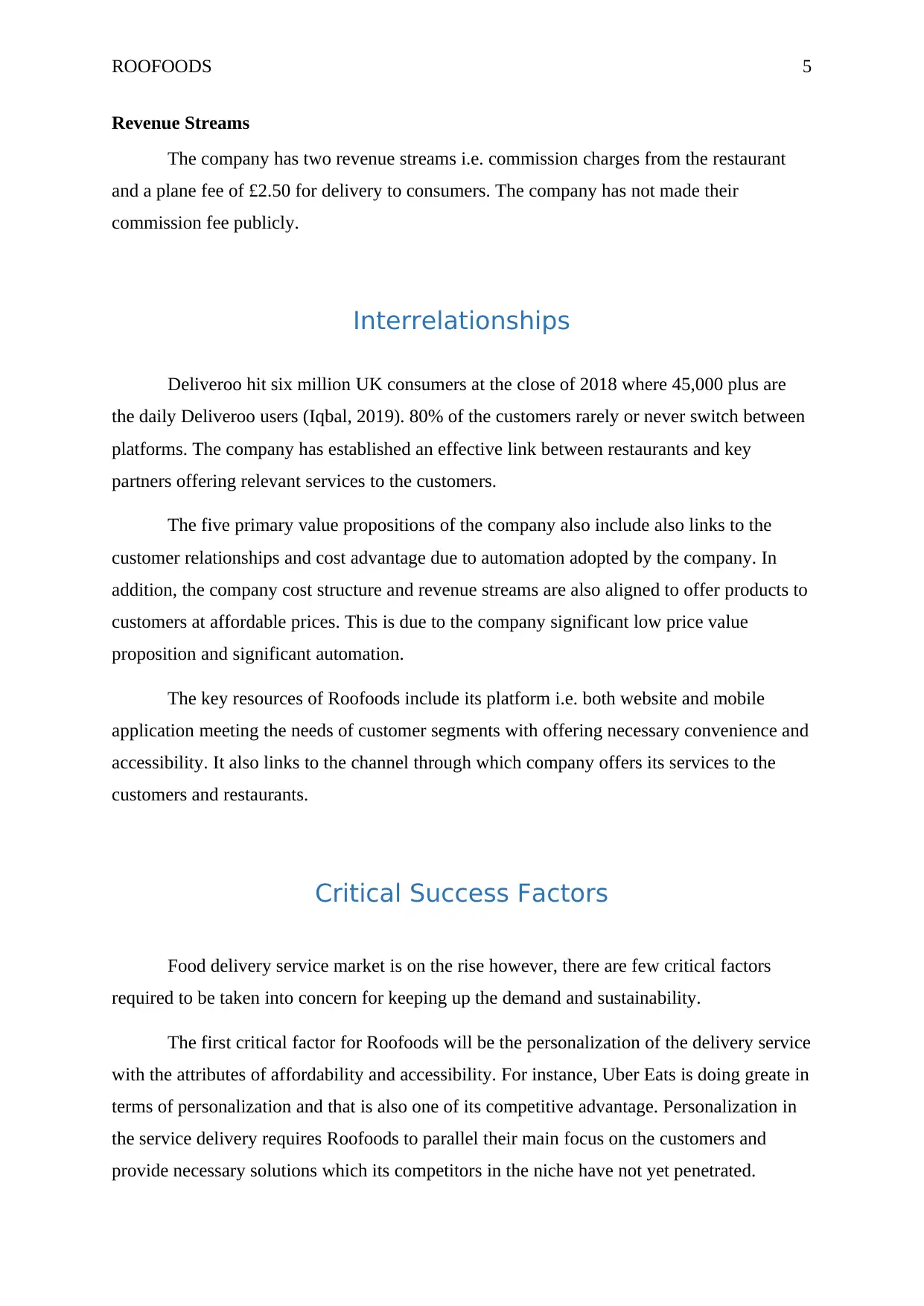
ROOFOODS 5
Revenue Streams
The company has two revenue streams i.e. commission charges from the restaurant
and a plane fee of £2.50 for delivery to consumers. The company has not made their
commission fee publicly.
Interrelationships
Deliveroo hit six million UK consumers at the close of 2018 where 45,000 plus are
the daily Deliveroo users (Iqbal, 2019). 80% of the customers rarely or never switch between
platforms. The company has established an effective link between restaurants and key
partners offering relevant services to the customers.
The five primary value propositions of the company also include also links to the
customer relationships and cost advantage due to automation adopted by the company. In
addition, the company cost structure and revenue streams are also aligned to offer products to
customers at affordable prices. This is due to the company significant low price value
proposition and significant automation.
The key resources of Roofoods include its platform i.e. both website and mobile
application meeting the needs of customer segments with offering necessary convenience and
accessibility. It also links to the channel through which company offers its services to the
customers and restaurants.
Critical Success Factors
Food delivery service market is on the rise however, there are few critical factors
required to be taken into concern for keeping up the demand and sustainability.
The first critical factor for Roofoods will be the personalization of the delivery service
with the attributes of affordability and accessibility. For instance, Uber Eats is doing greate in
terms of personalization and that is also one of its competitive advantage. Personalization in
the service delivery requires Roofoods to parallel their main focus on the customers and
provide necessary solutions which its competitors in the niche have not yet penetrated.
Revenue Streams
The company has two revenue streams i.e. commission charges from the restaurant
and a plane fee of £2.50 for delivery to consumers. The company has not made their
commission fee publicly.
Interrelationships
Deliveroo hit six million UK consumers at the close of 2018 where 45,000 plus are
the daily Deliveroo users (Iqbal, 2019). 80% of the customers rarely or never switch between
platforms. The company has established an effective link between restaurants and key
partners offering relevant services to the customers.
The five primary value propositions of the company also include also links to the
customer relationships and cost advantage due to automation adopted by the company. In
addition, the company cost structure and revenue streams are also aligned to offer products to
customers at affordable prices. This is due to the company significant low price value
proposition and significant automation.
The key resources of Roofoods include its platform i.e. both website and mobile
application meeting the needs of customer segments with offering necessary convenience and
accessibility. It also links to the channel through which company offers its services to the
customers and restaurants.
Critical Success Factors
Food delivery service market is on the rise however, there are few critical factors
required to be taken into concern for keeping up the demand and sustainability.
The first critical factor for Roofoods will be the personalization of the delivery service
with the attributes of affordability and accessibility. For instance, Uber Eats is doing greate in
terms of personalization and that is also one of its competitive advantage. Personalization in
the service delivery requires Roofoods to parallel their main focus on the customers and
provide necessary solutions which its competitors in the niche have not yet penetrated.
⊘ This is a preview!⊘
Do you want full access?
Subscribe today to unlock all pages.

Trusted by 1+ million students worldwide
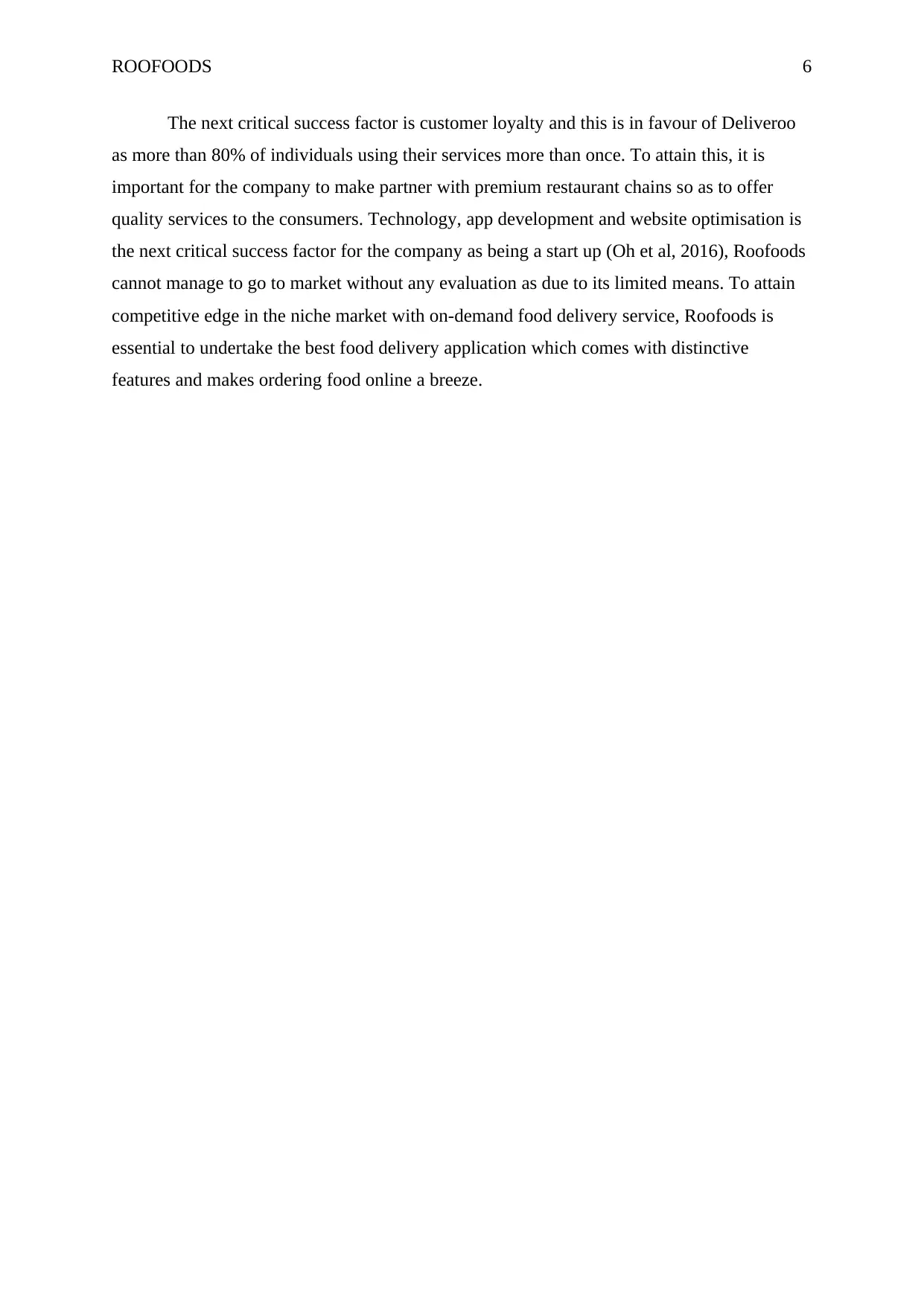
ROOFOODS 6
The next critical success factor is customer loyalty and this is in favour of Deliveroo
as more than 80% of individuals using their services more than once. To attain this, it is
important for the company to make partner with premium restaurant chains so as to offer
quality services to the consumers. Technology, app development and website optimisation is
the next critical success factor for the company as being a start up (Oh et al, 2016), Roofoods
cannot manage to go to market without any evaluation as due to its limited means. To attain
competitive edge in the niche market with on-demand food delivery service, Roofoods is
essential to undertake the best food delivery application which comes with distinctive
features and makes ordering food online a breeze.
The next critical success factor is customer loyalty and this is in favour of Deliveroo
as more than 80% of individuals using their services more than once. To attain this, it is
important for the company to make partner with premium restaurant chains so as to offer
quality services to the consumers. Technology, app development and website optimisation is
the next critical success factor for the company as being a start up (Oh et al, 2016), Roofoods
cannot manage to go to market without any evaluation as due to its limited means. To attain
competitive edge in the niche market with on-demand food delivery service, Roofoods is
essential to undertake the best food delivery application which comes with distinctive
features and makes ordering food online a breeze.
Paraphrase This Document
Need a fresh take? Get an instant paraphrase of this document with our AI Paraphraser
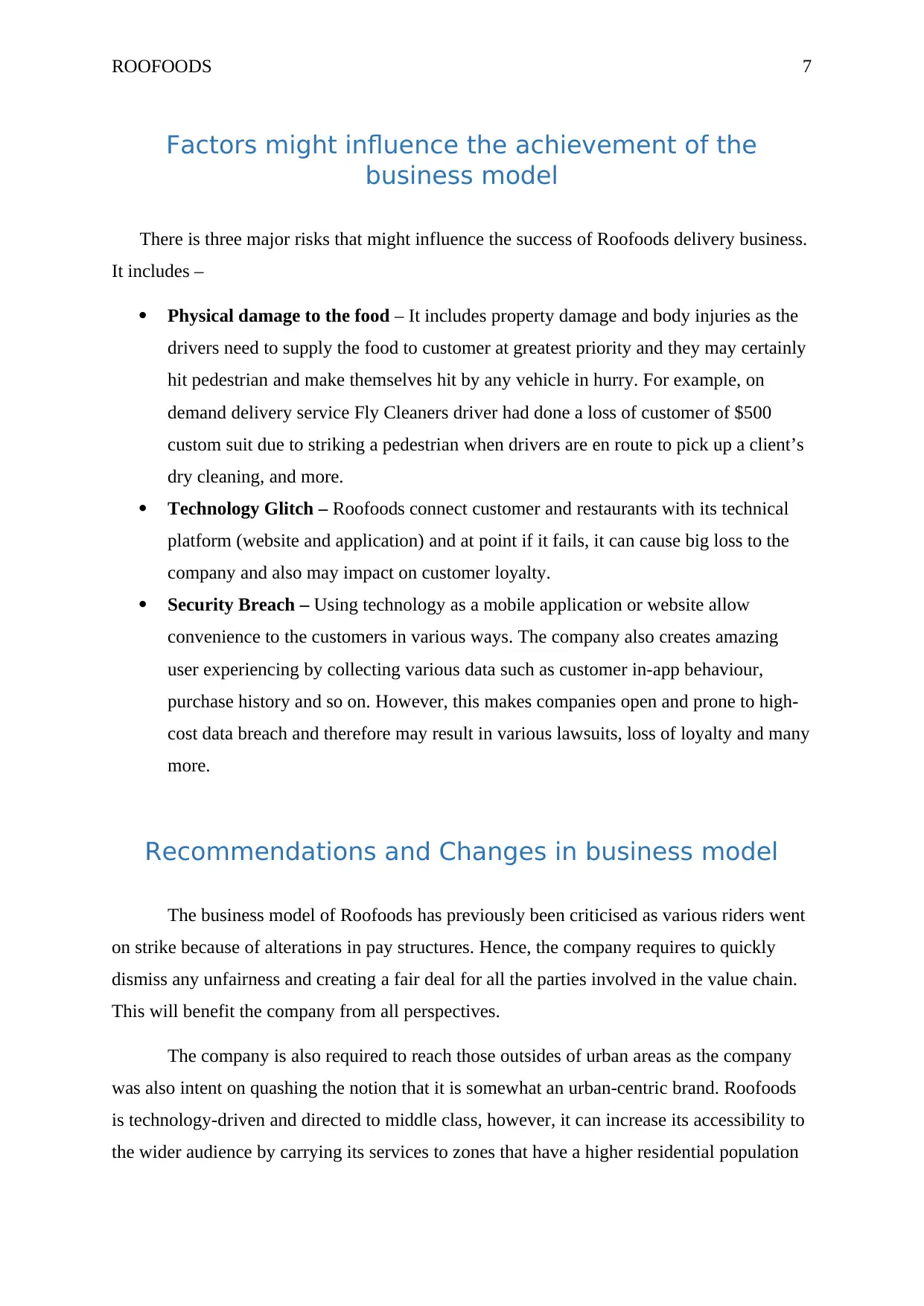
ROOFOODS 7
Factors might influence the achievement of the
business model
There is three major risks that might influence the success of Roofoods delivery business.
It includes –
Physical damage to the food – It includes property damage and body injuries as the
drivers need to supply the food to customer at greatest priority and they may certainly
hit pedestrian and make themselves hit by any vehicle in hurry. For example, on
demand delivery service Fly Cleaners driver had done a loss of customer of $500
custom suit due to striking a pedestrian when drivers are en route to pick up a client’s
dry cleaning, and more.
Technology Glitch – Roofoods connect customer and restaurants with its technical
platform (website and application) and at point if it fails, it can cause big loss to the
company and also may impact on customer loyalty.
Security Breach – Using technology as a mobile application or website allow
convenience to the customers in various ways. The company also creates amazing
user experiencing by collecting various data such as customer in-app behaviour,
purchase history and so on. However, this makes companies open and prone to high-
cost data breach and therefore may result in various lawsuits, loss of loyalty and many
more.
Recommendations and Changes in business model
The business model of Roofoods has previously been criticised as various riders went
on strike because of alterations in pay structures. Hence, the company requires to quickly
dismiss any unfairness and creating a fair deal for all the parties involved in the value chain.
This will benefit the company from all perspectives.
The company is also required to reach those outsides of urban areas as the company
was also intent on quashing the notion that it is somewhat an urban-centric brand. Roofoods
is technology-driven and directed to middle class, however, it can increase its accessibility to
the wider audience by carrying its services to zones that have a higher residential population
Factors might influence the achievement of the
business model
There is three major risks that might influence the success of Roofoods delivery business.
It includes –
Physical damage to the food – It includes property damage and body injuries as the
drivers need to supply the food to customer at greatest priority and they may certainly
hit pedestrian and make themselves hit by any vehicle in hurry. For example, on
demand delivery service Fly Cleaners driver had done a loss of customer of $500
custom suit due to striking a pedestrian when drivers are en route to pick up a client’s
dry cleaning, and more.
Technology Glitch – Roofoods connect customer and restaurants with its technical
platform (website and application) and at point if it fails, it can cause big loss to the
company and also may impact on customer loyalty.
Security Breach – Using technology as a mobile application or website allow
convenience to the customers in various ways. The company also creates amazing
user experiencing by collecting various data such as customer in-app behaviour,
purchase history and so on. However, this makes companies open and prone to high-
cost data breach and therefore may result in various lawsuits, loss of loyalty and many
more.
Recommendations and Changes in business model
The business model of Roofoods has previously been criticised as various riders went
on strike because of alterations in pay structures. Hence, the company requires to quickly
dismiss any unfairness and creating a fair deal for all the parties involved in the value chain.
This will benefit the company from all perspectives.
The company is also required to reach those outsides of urban areas as the company
was also intent on quashing the notion that it is somewhat an urban-centric brand. Roofoods
is technology-driven and directed to middle class, however, it can increase its accessibility to
the wider audience by carrying its services to zones that have a higher residential population
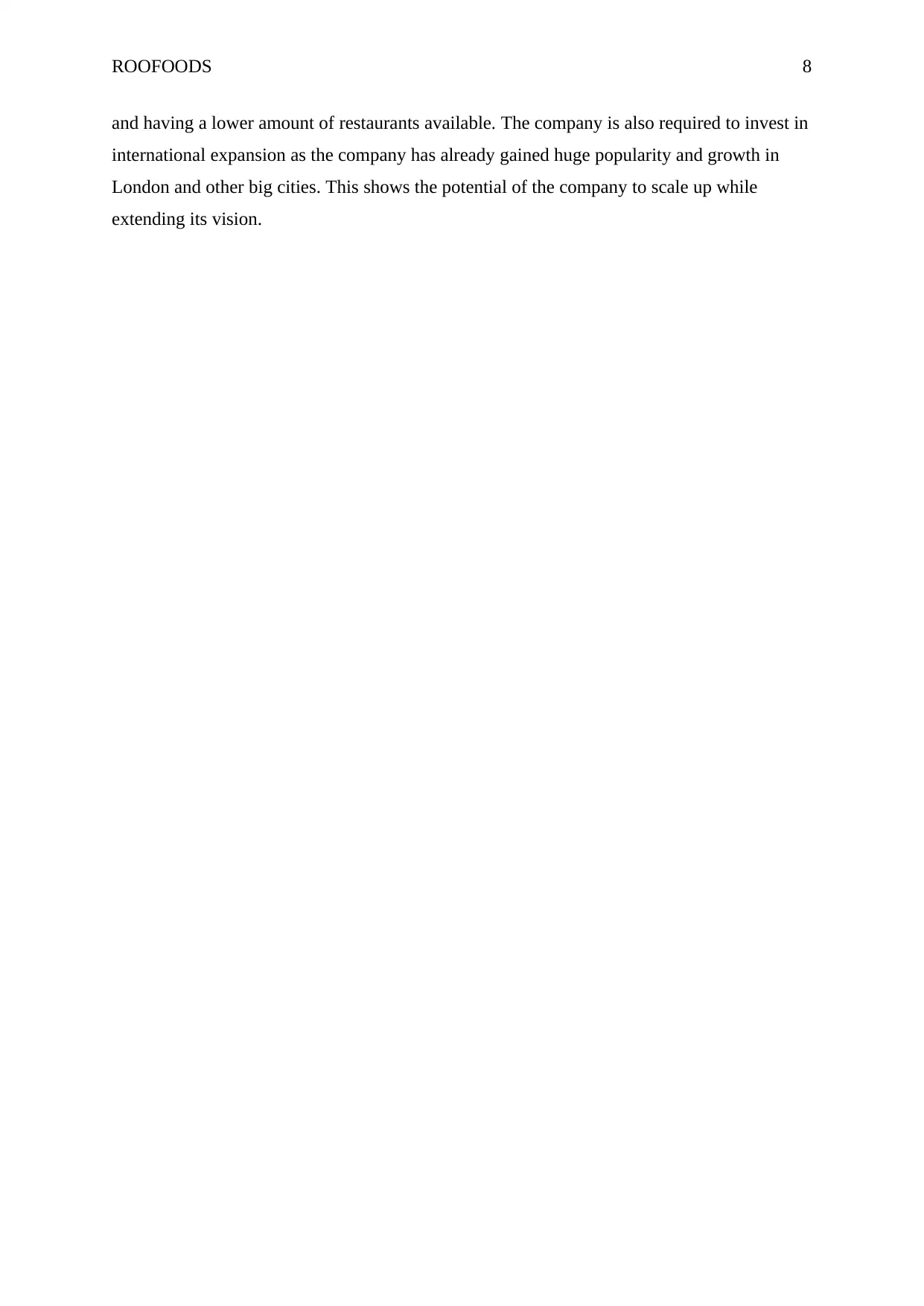
ROOFOODS 8
and having a lower amount of restaurants available. The company is also required to invest in
international expansion as the company has already gained huge popularity and growth in
London and other big cities. This shows the potential of the company to scale up while
extending its vision.
and having a lower amount of restaurants available. The company is also required to invest in
international expansion as the company has already gained huge popularity and growth in
London and other big cities. This shows the potential of the company to scale up while
extending its vision.
⊘ This is a preview!⊘
Do you want full access?
Subscribe today to unlock all pages.

Trusted by 1+ million students worldwide
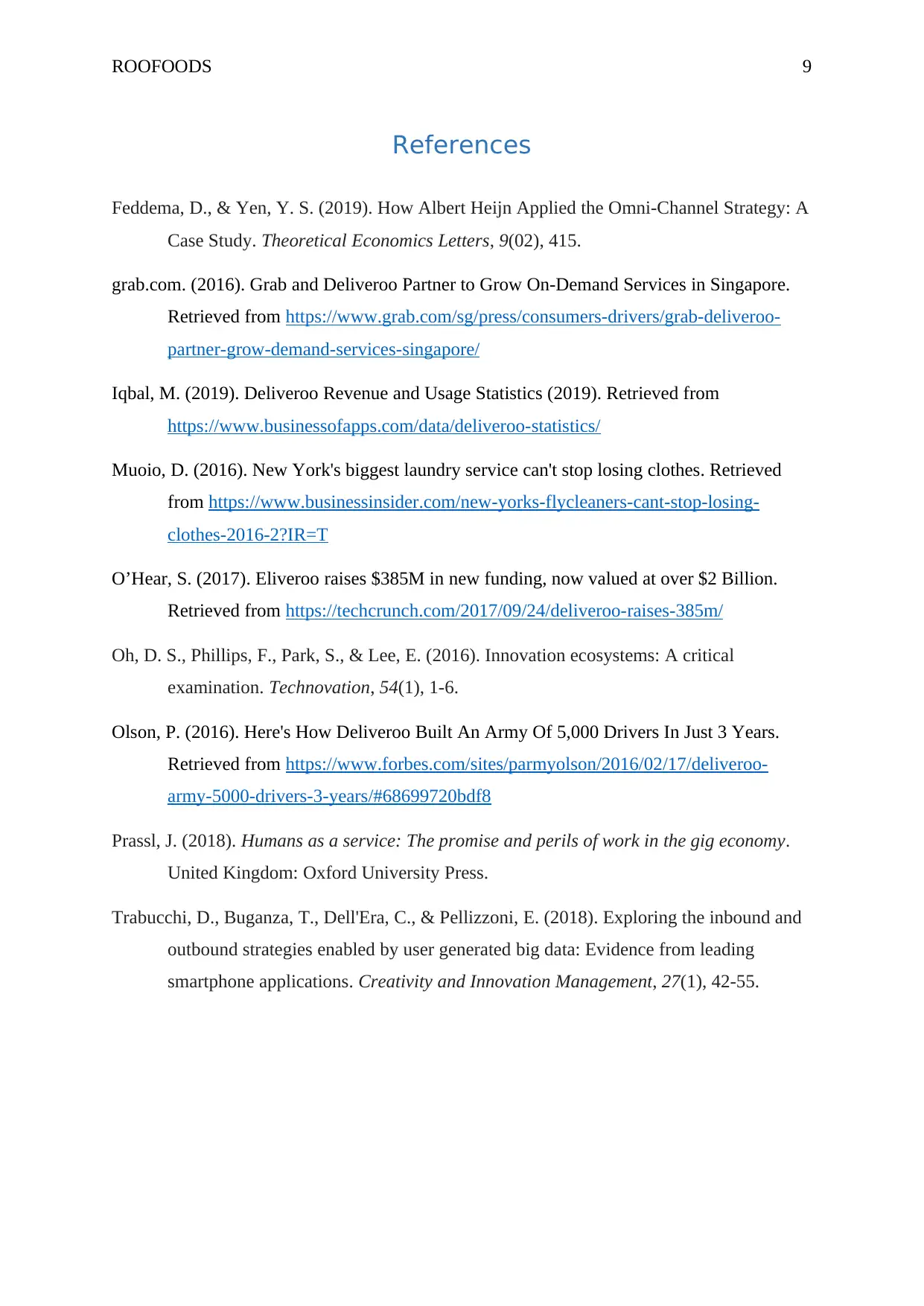
ROOFOODS 9
References
Feddema, D., & Yen, Y. S. (2019). How Albert Heijn Applied the Omni-Channel Strategy: A
Case Study. Theoretical Economics Letters, 9(02), 415.
grab.com. (2016). Grab and Deliveroo Partner to Grow On-Demand Services in Singapore.
Retrieved from https://www.grab.com/sg/press/consumers-drivers/grab-deliveroo-
partner-grow-demand-services-singapore/
Iqbal, M. (2019). Deliveroo Revenue and Usage Statistics (2019). Retrieved from
https://www.businessofapps.com/data/deliveroo-statistics/
Muoio, D. (2016). New York's biggest laundry service can't stop losing clothes. Retrieved
from https://www.businessinsider.com/new-yorks-flycleaners-cant-stop-losing-
clothes-2016-2?IR=T
O’Hear, S. (2017). Eliveroo raises $385M in new funding, now valued at over $2 Billion.
Retrieved from https://techcrunch.com/2017/09/24/deliveroo-raises-385m/
Oh, D. S., Phillips, F., Park, S., & Lee, E. (2016). Innovation ecosystems: A critical
examination. Technovation, 54(1), 1-6.
Olson, P. (2016). Here's How Deliveroo Built An Army Of 5,000 Drivers In Just 3 Years.
Retrieved from https://www.forbes.com/sites/parmyolson/2016/02/17/deliveroo-
army-5000-drivers-3-years/#68699720bdf8
Prassl, J. (2018). Humans as a service: The promise and perils of work in the gig economy.
United Kingdom: Oxford University Press.
Trabucchi, D., Buganza, T., Dell'Era, C., & Pellizzoni, E. (2018). Exploring the inbound and
outbound strategies enabled by user generated big data: Evidence from leading
smartphone applications. Creativity and Innovation Management, 27(1), 42-55.
References
Feddema, D., & Yen, Y. S. (2019). How Albert Heijn Applied the Omni-Channel Strategy: A
Case Study. Theoretical Economics Letters, 9(02), 415.
grab.com. (2016). Grab and Deliveroo Partner to Grow On-Demand Services in Singapore.
Retrieved from https://www.grab.com/sg/press/consumers-drivers/grab-deliveroo-
partner-grow-demand-services-singapore/
Iqbal, M. (2019). Deliveroo Revenue and Usage Statistics (2019). Retrieved from
https://www.businessofapps.com/data/deliveroo-statistics/
Muoio, D. (2016). New York's biggest laundry service can't stop losing clothes. Retrieved
from https://www.businessinsider.com/new-yorks-flycleaners-cant-stop-losing-
clothes-2016-2?IR=T
O’Hear, S. (2017). Eliveroo raises $385M in new funding, now valued at over $2 Billion.
Retrieved from https://techcrunch.com/2017/09/24/deliveroo-raises-385m/
Oh, D. S., Phillips, F., Park, S., & Lee, E. (2016). Innovation ecosystems: A critical
examination. Technovation, 54(1), 1-6.
Olson, P. (2016). Here's How Deliveroo Built An Army Of 5,000 Drivers In Just 3 Years.
Retrieved from https://www.forbes.com/sites/parmyolson/2016/02/17/deliveroo-
army-5000-drivers-3-years/#68699720bdf8
Prassl, J. (2018). Humans as a service: The promise and perils of work in the gig economy.
United Kingdom: Oxford University Press.
Trabucchi, D., Buganza, T., Dell'Era, C., & Pellizzoni, E. (2018). Exploring the inbound and
outbound strategies enabled by user generated big data: Evidence from leading
smartphone applications. Creativity and Innovation Management, 27(1), 42-55.
1 out of 10
Related Documents
Your All-in-One AI-Powered Toolkit for Academic Success.
+13062052269
info@desklib.com
Available 24*7 on WhatsApp / Email
![[object Object]](/_next/static/media/star-bottom.7253800d.svg)
Unlock your academic potential
Copyright © 2020–2025 A2Z Services. All Rights Reserved. Developed and managed by ZUCOL.





